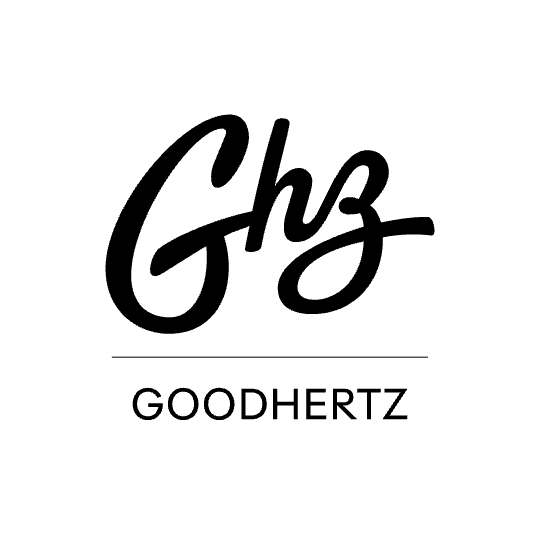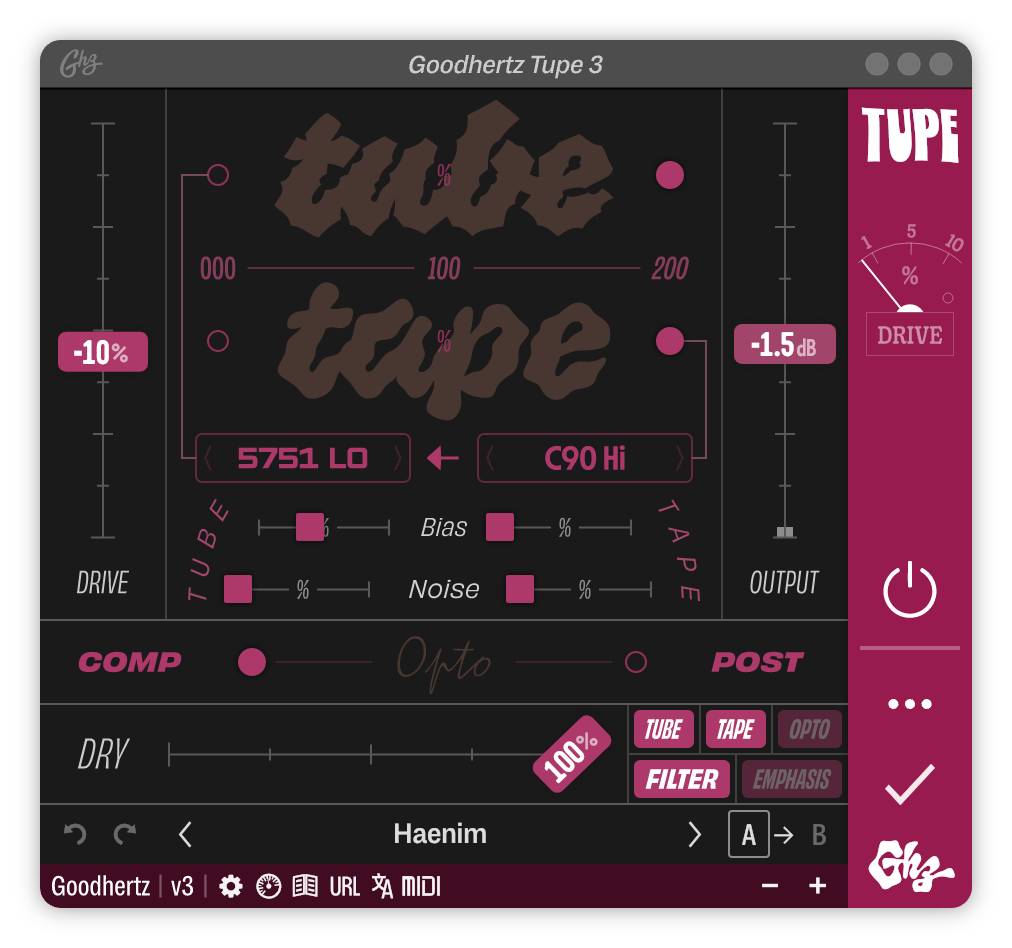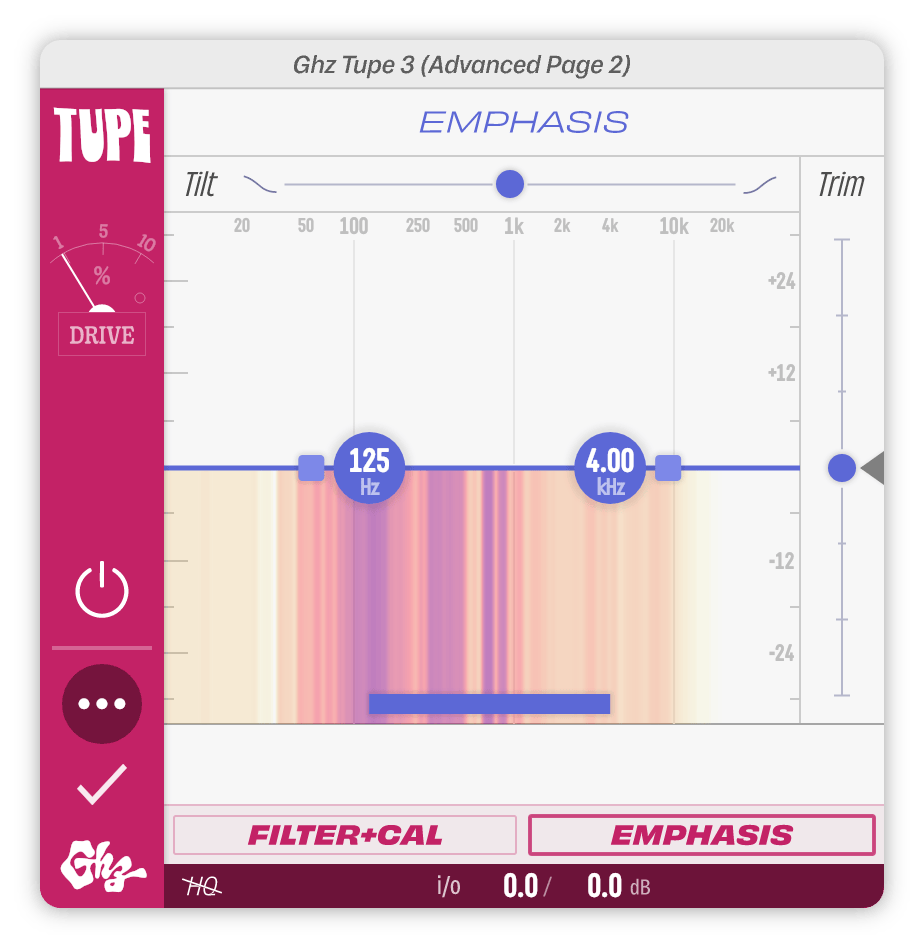Advanced Controls
Tupe has 2 pages of advanced controls. Click on the images below to see the advanced pages in detail. You can also read about the advanced pages in the plugin manual.
A timeless pairing — vacuum tube amplification & magnetic tape recording — brought to you in one essential plugin: Tupe (/'tüp/).
“Whether you’re looking for subtle harmonic excitement or over-the-top analog distortions, Tupe can do it all and more. […] Tupe is inspiring, fun to use, and adds depth and character to any source.”
From gentle harmonic enhancement to completely fuzzed-out distortion and saturation, Tupe was designed to reproduce and bring together some of our all-time favorite tape machines and tube circuits. Combined with Tupe’s super expressive filter, an innovative emphasis section, and its Opto-style limiter/compressor, there’s an infinite range of analog color and vibe waiting to be discovered in just a few clicks.
“This is digital doing what digital does best, whilst offering some of the most authentic analogue sounds I’ve heard to date.”
-
Nine tube circuit models
- 5751 Lo
- 5751 Med
- 5751 Hi
- 6L6 Lo
- 6L6 Med
- 6L6 Hi
- EL34 Lo
- EL34 Hi
- 12AX7
- More to come in future releases…
-
Four analog tape models
- 2 Track Hi
- 2 Track Lo
- C90 Hi
- C90 Lo
- More to come in future releases…
-
Opto compressor/limiter
- Configurable processing order
- Optional SAT mode for compressing only the pre-saturation signal (very useful for highly dynamic material if you want a consistent level of saturation without obvious clipping or distortion)
-
Bias controls for both tube and tape for greater harmonic control
-
1960’s-style ladder filter with fully independent slope (both boost & cut) & resonance (both boost & cut)
-
Self-oscillating resonant filter modeling
-
Tiltshift equalizer
-
Level-compensated input drive
-
HQ Mode for even more analog-like sound
-
Analog-style master mix / global amount control
-
Novel emphasis section that applies Tupe’s ladder filter to the ‘pre-saturation’ signal (before tube/tape), allowing you to emphasize the saturation in certain areas while relaxing it in others, letting them pass through Tupe unsaturated
Tube + Tape = Tupe
Before the 1970’s, it was almost impossible to make a record without lots of tubes and tape. Analog tape machines were the primary way that music was recorded, and tubes were the most common amplifier technology used in preamps, mixers (ex. EMI REDD1 consoles), powered microphones (ex. Neumann U67), and guitar & bass amps (Ampeg, Fender, Vox, etc).
The sound that tubes and tape make together is incredible & unmistakable, both with their own complimentary flavors of harmonic saturation and nonlinear distortion. Listen to anything recorded at Motown, Muscle Shoals, Abbey Road, Stax Records, or Gold Star Studios in the 1960’s and you’ll hear that sound: fat, crunchy, rich, present tones.
As one regular client of Gold Star Studios put it: “You could literally smell the tubes inside the mixing board as they heated up. There was a richness to the sound that Western and United, our usual studios, never had. Those two rooms sounded ‘clean’ while Gold Star felt fat & funky.”
Even after the 60’s, tubes and tape continued to define sounds made all over the world — from King Tubby’s dubs in Waterhouse to the psychedelic rock of Shin Joong Hyun (신중현) in Seoul. (Of course, you can always drop out the tube to get the sound of an 80’s Chicago house bootleg cassette; or drop out the tape to get the sound of a boutique Los Angeles guitar amplifier of today.)
Tupe brings these analog sounds into the digital realm and makes it possible to blend in as much (or as little) coloration as you want from each element. We’ve also made it possible to boost the input drive to extreme levels — levels that could have easily fried the actual analog electronics — for more intense analog clipping. By combining the tube and tape processing in a single efficient plugin, Tupe can achieve a level of flexibility and fidelity not possible with separate plugins.
What’s Tupe sound like? Here are some loops from our Tupe Loop Journal:
(Tupe coming in and out on an 808)
(Tupe crushing a drum machine & a Mustang)
(Tupe on some ambient electronic)
(Tupe on clawhammer banjo)
(Tupe on Vulfpeck)
-
Any products, companies, and studios referenced on this page are trademarks of their respective owners and are in no way associated or affiliated with Goodhertz, Inc. These names and descriptions are provided for historical reference only and in no way represent an endorsement, partnership, or relationship. ↩
Tupe in use
Rex Orange County - 2008
Tupe & Vulf Compressor were used on the main Sufjan Stevens sample throughout the song.
Fearless Flyers, “Running Man”
Fearless Flyers producer Jack Stratton recently texted this to us, regarding the snare in the Flyers’ “Running Man” :
“Meters” tupe peset taking this snare back in time. closest ive gotten to those al green records
Tupe on Drums
That lovely distortion you hear on Aaron Sterling’s kit is Tupe.
When will new tape and tube models be added to Tupe?
While we are planning on adding more tape and tube models to Tupe in the future, we don’t yet have a timeline for when those new models will be added. That said, if you buy the plugin now, you will get the updated version (and all the new tape and tube models) for free when they are available.
Can this version of Tupe be installed alongside the earlier Tupe betas?
Yes. If you’ve been using Tupe B1/B2, this release version can be installed in parallel and will not overwrite B1/B2. There is an issue with custom user presets created in older Tupe betas that do not load correctly in the release version. To workaround this, the presets can be copied and pasted manually (as URL’s) into the release version and recreated.
Can this version of Tupe be installed alongside the release candidate (RC1)?
No, this version will replace RC1, but it is fully backwards compatible with Tupe RC1.




